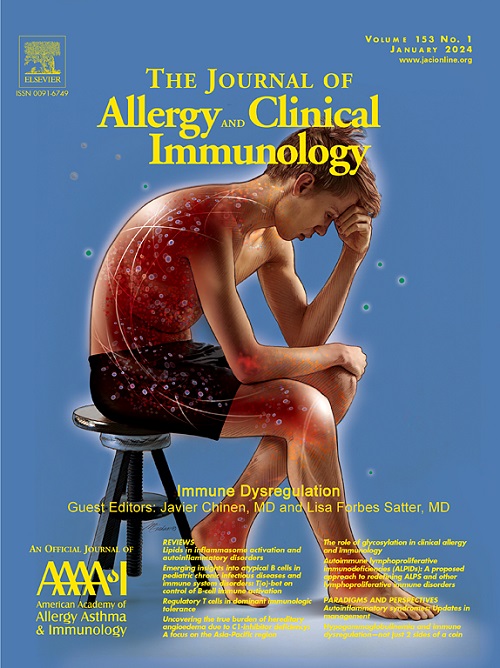Consensus of the Italian Primary Immunodeficiency Network on the use and interpretation of genetic testing for diagnosing inborn errors of immunity
IF 11.4
1区 医学
Q1 ALLERGY
引用次数: 0
Abstract
Background
Inborn errors of immunity (IEIs) comprise more than 500 different rare congenital disorders of the immune system and are characterized by susceptibility to infection and immune dysregulation. The significant overlap of the clinical features among the different forms may lead to diagnostic delay. High-throughput sequencing techniques may allow a timely genetic definition. Guidelines for the use and the interpretation of genetic testing produced by the American College of Medical Genetics and Genomics (ACMG) and the European Society of Human Genetics (ESHG) do not cover specifics for their application to IEIs.
Objective
The aim of this consensus study was to define the best approach to genetic testing for IEIs.
Methods
A panel of experts in the context of the Italian Primary Immunodeficiency Network (IPINet) composed a list of statements that were evaluated by the Delphi method.
Results
The experts recommend that genetic testing for IEIs should be offered to selected patients with warning signs for IEIs and highlight the crucial role of thorough phenotyping and functional tests for the conclusive diagnosis of IEI. Comprehensive educational programs targeted to health care professionals and the public should be developed to increase IEIs awareness and reduce diagnostic delay. Ethical issues should be pondered over the diagnostic advantages of genetic tests requested for diagnostic purposes.
Conclusion
Adherence to guidelines on the use and interpretation of genetic tests for diagnosing IEIs should help limit the inappropriate use of these techniques, thereby reducing the risk of misdiagnosis and patient apprehension regarding inconclusive genetic results.
意大利原发性免疫缺陷网络关于基因检测用于先天性免疫缺陷(IEI)诊断的使用和解释的共识。
背景:先天性免疫错误(IEIs)是500多种不同的罕见先天性免疫系统疾病,其特征是对感染的易感性和免疫失调。不同形式的临床特征的显著重叠可能导致诊断延迟。高通量测序技术可能允许一个及时的遗传定义。美国医学遗传学和基因组学学院(ACMG)和欧洲人类遗传学学会(ESHG)制定的基因检测使用和解释指南没有涵盖应用于iei的特异性。目的:本共识研究的目的是确定iei基因检测的最佳方法。方法:在意大利原发性免疫缺陷网络(IPINet)的背景下,一个专家小组组成了一个陈述列表,使用德尔菲法进行评估。结果:专家建议对有IEI警告信号的特定患者进行IEI基因检测,并强调彻底的表型和功能检测对于IEI的结论性诊断至关重要。应制定针对卫生保健专业人员和公众的综合教育计划,以提高对iei的认识并减少诊断延误。伦理问题应该考虑到用于诊断目的的基因测试的诊断优势。结论:坚持使用和解释基因检测诊断iei的指南应有助于限制这些技术的不当使用,减少误诊的风险和对不确定遗传结果的担忧。
本文章由计算机程序翻译,如有差异,请以英文原文为准。
求助全文
约1分钟内获得全文
求助全文
来源期刊
CiteScore
25.90
自引率
7.70%
发文量
1302
审稿时长
38 days
期刊介绍:
The Journal of Allergy and Clinical Immunology is a prestigious publication that features groundbreaking research in the fields of Allergy, Asthma, and Immunology. This influential journal publishes high-impact research papers that explore various topics, including asthma, food allergy, allergic rhinitis, atopic dermatitis, primary immune deficiencies, occupational and environmental allergy, and other allergic and immunologic diseases. The articles not only report on clinical trials and mechanistic studies but also provide insights into novel therapies, underlying mechanisms, and important discoveries that contribute to our understanding of these diseases. By sharing this valuable information, the journal aims to enhance the diagnosis and management of patients in the future.

 求助内容:
求助内容: 应助结果提醒方式:
应助结果提醒方式:


